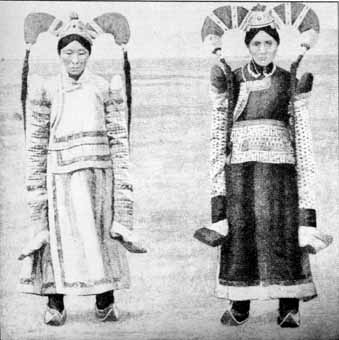Thursday, July 29, 2010
Mongolian clothing - A quick lesson by Soyolmaa
The real Mongolian gets the nod from Western fashion designers.
Mongolia's top fashion designer, Solyolmaa, gives Ger a quick lesson on Mongolian clothing
By A. Delgermaa
Last year's fashion runways were dominated by one influence: Mongolian traditional design. If a designer wanted to show they were boldly embracing natural fibers and furs, then the refrain " my show is all Mongolian" would be proudly boasted to the media. The country has become a synonym for sartorial flare and rugged beauty. It also doesn't hurt that one of Mongolia's top exports, cashmere wool, is in vogue, from Japan to Europe to the United States. After years of being isolated from the west under the umbrella of the Soviet Union, Mongolian fashion is proudly strutting the catwalks of the world.
Her square glasses reminiscent of Yves St. Laurent, Mongolia's top designer, Soyolmaa, talked to Ger about the ubiquitous nature of traditional clothes in the late 1990s. "There are few countries who still wear the national costume these days. Mongolia is one of them," she says sitting regally in the studio of her home, surrounded by models draped in dresses for her latest collection: a tribute to the style and attitude of Mongolia's ancient queens. "Because the
design of Mongolian national clothes is highly developed, no further changes are needed." As head of the Mongolian National Designers' Union, she has spent many years trying to find ways to improve the national costume to "no effect" she adds.
Busy tailors come and go, checking designs. The studio is crowded with four tailors and the models(not to mention this reporter). Two clients patiently wait in the hallway to see her. In a country where the soldiers and police wear uniforms designed by Pierre Cardin, it is no surprise Mongolians aren't slouches when it comes to clothes. While budgets may be tight and the shops far from world standard, people still find a way to dress with flair.
It is still common to see the traditional del – a cloak of either wool, leather or silk – worn by men and women of all ages, even in the capital. As herders are quick to say, the del serves many practical purposes. It is padding for long rides on the steppe, it is a makeshift tent in bad weather, it is a warm blanket, and for women, a nod to modesty when nature calls on the open steppe. While it is standard wear for older generations, younger urban Mongolians turn to the del on special occasions like school graduation ceremonies.
Last year collections by Christian Dior, Channel, UNGARO and Pierre Carden all paid homage to Mongolian design, typically characterized by variations on the del cloak, flamboyant displays of fur and knee-high boots.
"Asian styles are now having a big impact on world fashion design," continues Soyolmaa. "It is because Asian clothes offer pure, simple patterns with eye-catching colours and adornments. There is a trend towards In modern Mongolia, the choice can be traditional or Western purism in the fashion world. They like high collars, askew lapels, loose sleeves and nudarga (long sleeves). The bright colors of Asia are showing up throughout Western design. You can see the askew lapel and high collar and bright colors from Christian Dior to Channel."
The Mongolian national costume is a classic example of purism. The pattern is very simple, with no separate sleeves or shoulder parts, and very economical with little waste of cloth.
And why did this style evolve over the generations? Soyolmaa has a simple answer: "It is because of the harsh weather of Mongolia." The askew lapel doesn't let wind pierce the body, nudarga or long sleeves don't make arms cold in the minus 30 to 40 degrees Celsius winters. Winter dels have fur interiors, using wolf, fox, sheep or lamb's wool. From ancient times to now, Mongolian men wear wolf fur coats in winter when guarding horses at night.
There are about a hundred styles of hat. Loovuus, made of fox fur with a cloth top, is a common hat in winter. The back part is open. "Fox fur is very dense. Without an open back one feels too hot and it causes high blood pressure and a headache," according to Soyolmaa. The extraordinary design of boots with pointed toes is suitable for riding a horse while leaving enough dead air space to keep the toes warm.
Soyolmaa takes difference with those who claim "Fashion sense ends in Mongolia." "It might because they have nothing to compare it with. But now that fashion shows are available on cable TV, Mongolians are learning how to compare Mongolian fashion and models with the global standard." For Soyolmaa, as it is the time for Asian fashion, it is also the time for Asian models. "Irina Pantieva, the world's top model is Mongolian. She is from the Buriat Republic (a province of Russia directly north of Mongolia and populated by a large number of people of Mongolian heritage)." She says Mongolian models are ready to take on the world.
To the soothing sounds of Enigma, Mongolia's top models parade Soyolmaa's tributes to Mongolian queens in early May at the Las Vegas Entertainment Centre, a former communist-era cinema. Long silk dresses are complemented with furs and enormous hats, at times evoking Cleopatra, at other times something from a Dr. Seus cartoon, some hats reaching a meter high. Judging by the audience's reaction and the quality of Soyolmaa's creations, the time has come for Mongolian designers to take centre stage on the world fashion scene.
Subscribe to:
Post Comments (Atom)


No comments:
Post a Comment